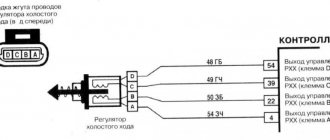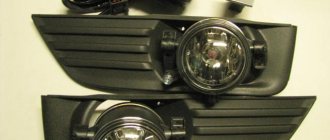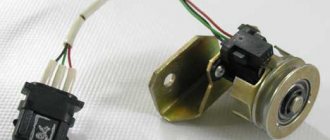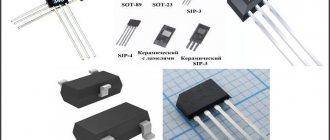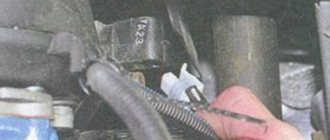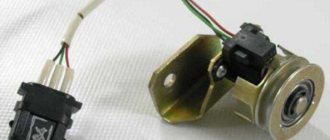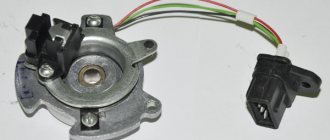Using the example of a Hall sensor used in the contactless ignition system of VAZ 2108, 2109, 21099 cars.
The Hall sensor is designed to determine the spark torque in the contactless ignition system (BCG) of a car.
Working principle of the Hall sensor
The principle of operation of the sensor is based on the Hall effect, when the magnetic field of a conductor changes when a special screen with slots passes through it.
In practice, it looks like this: the Hall sensor of VAZ 2108, 2109, 21099 cars is installed on the distributor base plate and consists of two parts - a magnet and a Hall element with an amplifier. Voltage to the Hall sensor is supplied from the switch (pin 5) via the red current wire. The "ground" also comes from the switch: a black and white wire from pin 3. The magnet creates a magnetic field, the Hall element receives it, creates a voltage that amplifies the amplifier, and through a green pulse the voltage is applied to the switch. (conclusion 6).
To change the magnetic field, a shield with four slots is used, which rotates as the ignition distributor shaft (distributor) passes between the magnet and the receiving part of the Hall sensor. When the screen slot passes through the groove of the sensor, the magnetic field has a certain value, and as a result, the sensor supplies an electric current of a certain voltage (9-12 V) to the switch. When the shield tooth passes through the sensor groove, the magnetic field is shielded and does not enter the sensor receiver, and the voltage supplied to the switch drops (0-0.5 V).
As a result, the switch turns off the electric current supplied to the ignition coil, the magnetic field inside it is greatly compressed and, passing through the turns of the winding, creates an EMF of 22-25 kV (high voltage current). The current flows through the armored wires to the distributor and then to the spark plugs, creating a discharge that ignites the fuel mixture. The passage of each of the four screen teeth into the sensor groove corresponds to the compression stroke in one of the four engine cylinders.
Notes and additions
— The operating principle of many other automotive sensors is based on the Hall effect, for example, the injection speed sensor VAZ 21083, 21093, 21099.
More articles about car sensors VAZ 2108, 2109, 21099
The Hall sensor is one of the most important elements of the contactless ignition system for gasoline engines. The slightest malfunction of this part leads to serious malfunctions in the engine. Therefore, in order to avoid diagnostic errors, it is important to know how to check the Hall sensor and, if necessary, be able to replace it.
We have divided this material into two parts: theoretical (purpose, design and principle of operation of the Hall sensor) and practical - signs of malfunction, test methods and replacement methods.
At the end of the article, watch a video tutorial on how to replace the Hall sensor yourself.
And before checking the Hall sensor for faults, let's understand its purpose and operating principles.
What is a Hall sensor and how does it work
The Hall sensor (also known as a camshaft position sensor) is one of the main elements of the distributor (switch-distributor). It is located next to the distributor shaft, on which a magnetically conductive plate, similar to a crown, is attached. There are as many grooves in the plate as there are cylinders in the engine. There is also a permanent magnet inside the sensor.
The principle of operation of the Hall sensor is as follows: when the shaft rotates, metal blades alternately pass through a slot in the sensor. As a result, a pulse voltage is generated, which is supplied through a switch to the ignition coil and, converted into high voltage, is supplied to the spark plugs.
The Hall sensor has three outputs:
- you connect to the "mass"
- the second one is suitable for a plus with a voltage of about 6V,
- From the third output, the converted pulse signal is supplied to the switch.
Electrical diagram of VAZ 21083
1- block headlight; 2- electric motors for headlight cleaners; 3- fog lights; 4- engine compartment lamp switch; 5 - sound signal; 6- electric motor of the engine cooling system fan; 7- fan motor activation sensor; 8- front brake pad wear sensor; 9- generator; 10 - solenoid valve for turning on the headlight washers; 11- solenoid valve for turning on the rear window washer; 12- solenoid valve for turning on the windshield washer; 13- glass washer motor; 14- oil pressure warning lamp sensor; 15- oil level sensor; 16- washer fluid level sensor; 17 - fuel consumption sensor; 18- carburetor solenoid valve; 19- carburetor limit switch; 20- starter enable relay; 21- spark plugs; 22- ignition distributor sensor; 23 - vehicle speed sensor; 24- carburetor solenoid valve control unit; 25- diagnostic block; 26- ignition coil; 27- reverse light switch; 28 - coolant temperature indicator sensor; 29- starter; 30 - top dead center sensor of the 1st cylinder; 31- switch; 32- battery; 33- coolant level sensor; 34- relay for turning on fog lights; 35- brake fluid level sensor; 36- mounting block; 37-plug socket for a portable lamp; 38- door lock control unit; 39- engine compartment lamp; 40- electric motor for windshield wiper; 41- glove compartment lighting lamp; 42- heater fan electric motor; 43- additional resistor of the heater electric motor; 44- heater fan switch; 45- heater backlight lamp; 46- gearmotors for electric windows of the front doors; 47- gearmotors for blocking door locks; 48- ignition switch; 49- right door power window switch; 50- left door power window switch; 51- ignition relay; 52- steering column switch; 53- trip computer; 54- cigarette lighter; 55 - instrument lighting regulator; 56- parking brake warning lamp switch; 57- brake light switch; 58 - indicator lamp for turning on the heated rear window; 59- rear window heating switch; 60 - fog light switch; 61 - control lamp for turning on fog lights; 62 - indicator lamp for turning on the rear fog light; 63- rear fog light switch; 64- side direction indicators; 65 - lamp switch on the door pillars; 66- fog light circuit fuse; 67 - external lighting switch; 68 - instrument cluster VAZ 2108; 69- carburetor air damper warning lamp switch; 70- hazard switch; 71- lampshade; 72- connector for connecting to an individual lighting lamp; 73- rear lights; 74- license plate light; 75 - rear window wiper motor; 76 - rear window heating element; 77 - level indicator and fuel reserve sensor.
The numbering order of the plugs in the blocks is: A – mounting block, instrument cluster, steering column switch, ignition switch and windshield wiper; B – headlight and rear window cleaners; B – speed and fuel consumption sensor and in the ignition distributor; G – gear motors for power windows and gear motors for locking door locks.
Full size diagram:
Signs of a Hall sensor malfunction
Hall sensor malfunctions manifest themselves in different ways. Even an experienced technician will not always immediately determine the cause of an engine malfunction.
Here are some of the most common symptoms:
- The engine starts poorly or does not start at all.
- At idle, there are interruptions and jerks in the engine operation.
- The car may shake when driving at higher speeds.
- The power unit is blocked while driving.
If any of these signals appear, you must first check the functionality of the Hall sensor.
Also, other ignition system malfunctions found in cars should not be excluded from view.
How to check the Hall sensor
A simple way to check the camshaft position (Hall) sensor is shown in the following video.
There are several ways to check the operation of the Hall sensor. Each motorist will be able to choose the most suitable option for himself:
- Get a working sensor for testing from a neighbor or when the car is demolished and install it in the place of the original one. If the engine problems go away, you will need to purchase a new part.
- Using a tester, you can measure the voltage at the sensor output. In a working device, the voltage will vary from 0.4V to 11V.
- You can create a simulation of a Hall sensor. To do this, remove the three-pin block from the distributor. Then turn on the ignition and connect terminals 3 and 6 of the switch with a piece of wire. The appearance of a spark indicates a sensor failure.
If after inspection it is discovered that the Hall sensor is faulty, it must be replaced with a new one.
Relay and fuse diagram 2108
The relay and fuse box is located under the hood, in the compartment in front of the windshield on the left side.
Fuse block 2114-3722010-18
K1-relay for turning on headlight cleaners VAZ 2108; K2-relay-breaker for direction indicators and hazard warning lights; K3 - windshield wiper relay; K4-relay for monitoring the health of lamps; K5-power window relay; K6 - relay for turning on sound signals; K7-relay for turning on the electric heating of the rear window; K8-relay for high beam headlights; K9-relay for low beam headlights; F1-F16 - fuses.
Fuse block 2114-3722010-60
K1 - Headlight wiper relay, K2 - Turn signal and hazard warning relay, K3 - Windshield wiper relay, K4 - Brake light and parking light relay, K5 - Power window relay, K6 - Horn relay , K7 - Relay for turning on the heated rear window, K8 - Relay for turning on the high beam headlights, K9 - Relay for turning on the low beam headlights, F1 - F16 - VAZ 2108 fuses, F1 - F20 - Spare fuses.
Hall sensor replacement
Replacing the Hall sensor is easy. Even a novice car enthusiast can handle this work with his own hands.
The video below shows in sufficient detail the process of replacing the sensor in the distributor of a UAZ vehicle.
Typically, replacing a Hall sensor consists of several steps:
- First of all, the distributor is removed from the car.
- Then the distributor cap is removed and the timing mark is aligned with the crankshaft mark.
- Having remembered the location of the distributor, you need to unscrew the fasteners with a wrench.
- If there are clips and caps, these should also be removed.
- The shaft is pulled out of the distributor.
- All that remains is to disconnect the terminals of the Hall sensor and unscrew it.
- By pulling out the regulator, the faulty part is carefully removed through the resulting gap.
- The new Hall sensor is installed in the reverse order.
Checking the performance of the Hall sensor allows you to do much more than just determine the cause of engine failure. Thanks to simple techniques, the driver will save time on repairs and also eliminate unnecessary waste of money.
Location
In VAZ 2109 cars with a carburetor, the Hall sensor is responsible for closing and opening the contact group. When the window screen rotates, a signal is sent to the device, which is converted into an electrical signal. Through the switch, the signal is transmitted to the ignition coil, where it is converted into an electrical discharge, that is, a spark.
In a car with a carburetor, the sensor is located on the ignition distributor under the dust cover. It is secured to the base plate with two screws or rivets, depending on the valve type.
Electrical wiring diagrams
2108 with low instrument panel with mounting block type 17.3722
1 – block headlight; 2 – gear motor for headlight cleaner*; 3 – engine compartment lamp switch; 4 – sound signal; 5 – electric motor of the engine cooling system fan; 6 – fan motor activation sensor; 7 – generator; 8 – solenoid valve for turning on the headlight washers*; 9 – solenoid valve for turning on the rear window washer* (not installed on the VAZ-21099); 10 – solenoid valve for turning on the windshield washer; 11 – electric motor for glass washer; 12 – oil pressure warning lamp sensor; 13 – carburetor solenoid valve; 14 – carburetor limit switch; 15 – spark plugs; 16 – plug socket for a portable lamp; 17 – engine compartment lamp; 18 – ignition distributor sensor; 19 – carburetor solenoid valve control unit; 20 – windshield wiper gearmotor; 21 – switch; 22 – ignition coil; 23 – starter; 24 – top dead center sensor of the 1st cylinder**; 25 – diagnostic block**; 26 – starter activation relay; 27 – coolant temperature indicator sensor; 28 – reverse light switch; 29 – battery; 30 – brake fluid level sensor; 31 – mounting block; 32 – parking brake warning lamp switch; 33 – brake light switch; 34 – glove box lighting lamp; 35 – heater fan electric motor; 36 – additional resistor of the heater electric motor; 37 – heater fan switch; 38 – backlight lamp for heater levers; 39 – cigarette lighter; 40 – rear window heating switch; 41 – rear fog light switch; 42 – fog light circuit fuse; 43 – alarm switch; 44 – external lighting switch; 45 – ignition relay; 46 – ignition switch; 47 – steering column switch; 48 – instrument lighting switch; 49 – side direction indicator; 50 – lamp switch on the front door pillar; 51 – lamp switch on the rear door pillar (not installed on VAZ-2108 and VAZ-21083); 52 – lampshade; 53 – sockets for connecting individual interior lighting to the lampshade; 54 – switch for the carburetor air damper warning lamp; 55 – turn signal indicator lamp; 56 – indicator lamp for external lighting; 57 – rear fog light indicator lamp; 58 – backup warning lamp; 59 – control lamp for high beam headlights; 60 – indicator lamp for heated rear window; 61 – speedometer VAZ 2108; 62 – instrument cluster; 63 – instrument cluster lighting lamps; 64 – coolant temperature indicator; 65 – voltmeter; 66 – fuel level indicator with reserve indicator lamp; 67 – econometrician; 68 – “STOP” indicator lamp; 69 – battery charge indicator lamp; 70 – control lamp for the carburetor air damper; 71 – hazard warning lamp; 72 – brake fluid level warning lamp; 73 – parking brake warning lamp; 74 – oil pressure warning lamp; 75 – rear light; 76 – sensor for level indicator and fuel reserve; 77 – pads for connecting to the rear window heating element; 78 – license plate lights; 79 – rear window wiper gear motor* (not installed on VAZ-21099)
* Installed on parts of manufactured cars. ** Not installed since 1995
2108 with high instrument panel with mounting block type 17.3722
1 – block headlight; 2 – gear motor for headlight cleaner; 3 – fog lamp; 4 – sound signal; 5 – electric motor of the engine cooling system fan; 6 – engine compartment lamp switch; 7 – fan motor activation sensor; 8 – wire lugs connected to sensor 7 in case of installation of a mounting block type 17.3722; 9 – connectors for connecting to front brake pad wear sensors; 10 – washer fluid level sensor; 11 – solenoid valve for turning on the headlight washer; 12 – solenoid valve for turning on the rear window washer (not installed on the VAZ-21099); 13 – solenoid valve for turning on the windshield washer; 14 – windshield washer motor; 15 – oil level sensor; 16 – generator; 17 – oil pressure warning lamp sensor; 18 – carburetor limit switch; 19 – spark plugs; 20 – carburetor solenoid valve; 21 – engine compartment lamp; 22 – ignition distributor sensor; 23 – carburetor solenoid valve control unit; 24 – windshield wiper gearmotor; 25 – ignition coil; 26 – starter; 27 – switch; 28 – starter activation relay; 29 – coolant temperature indicator sensor; 30 – brake fluid level sensor; 31 – reverse light switch; 32 – battery; 33 – relay for turning on fog lights; 34 – coolant level sensor; 35 – mounting block; 36 – parking brake warning lamp switch; 37 – brake light switch; 38 – door lock control unit; 39 – cigarette lighter; 40 – glove box lighting lamp; 41 – heater fan electric motor; 42 – additional resistor of the heater electric motor; 43 – heater fan switch; 44 – backlight lamp for heater levers; 45 – gearmotors for electric windows of the front doors; 46 – gearmotors for locking front door locks; 47 – gearmotors for locking rear doors; 48 – headlight cleaner switch; 49 – power window switch for the right front door; 50 – ignition switch; 51 – power window switch of the left front door; 52 – ignition relay VAZ 2108; 53 – pads for connecting to the heating elements of the front seats; 54 – right front seat heating switch; 55 – left front seat heating switch; 56 – relay for turning on the heating of the front seats; 57 – front seat heating circuit fuse; 58 – instrument lighting switch; 59 – steering column switch; 60 – indicator lamp for turning on the heated rear window; 61 – rear window heating switch; 62 – control lamp for turning on fog lights; 63 – fog lamp switch; 64 – indicator lamp for turning on the rear fog light; 65 – rear fog light switch; 66 – side direction indicator; 67 – lamp switch on the rear door pillar (not installed on VAZ-21083); 68 – lamp switch on the front door pillar; 69 – canopy for individual interior lighting; 70 – lampshade; 71 – external lighting switch; 72 – instrument cluster; 73 – switch for the carburetor air damper warning lamp*; 74 – alarm switch; 75 – warning lamp for turning on the hazard warning lights; 76 – block for connection to the trip computer; 77 – rear light; 78 – block for connection to the rear window heating element; 79 – rear window wiper motor reducer (not installed on VAZ-21099); 80 – blocks for connecting to an additional brake light; 81 – license plate lights; 82 – level indicator and fuel reserve sensor
* Not installed on vehicles equipped with a carburetor with a semi-automatic starting device.
2108 with high instrument panel with mounting block type 2114-3722010
1 – block headlight; 2 – gear motor for headlight cleaner; 3 – fog lamp; 4 – sound signal; 5 – electric motor of the engine cooling system fan; 6 – engine compartment lamp switch; 7 – fan motor activation sensor; 8 – wire lugs connected to sensor 7 in case of installation of a mounting block type 17.3722; 9 – connectors for connecting to front brake pad wear sensors; 10 – washer fluid level sensor; 11 – solenoid valve for turning on the headlight washer; 12 – solenoid valve for turning on the rear window washer (not installed on the VAZ-21099); 13 – solenoid valve for turning on the windshield washer; 14 – windshield washer motor; 15 – oil level sensor; 16 – generator; 17 – oil pressure warning lamp sensor; 18 – carburetor limit switch; 19 – spark plugs; 20 – carburetor solenoid valve; 21 – engine compartment lamp; 22 – ignition distributor sensor; 23 – carburetor solenoid valve control unit; 24 – windshield wiper gearmotor; 25 – ignition coil; 26 – starter; 27 – switch; 28 – starter activation relay; 29 – coolant temperature indicator sensor; 30 – brake fluid level sensor; 31 – reverse light switch; 32 – battery; 33 – relay for turning on fog lights; 34 – coolant level sensor; 35 – mounting block; 36 – parking brake warning lamp switch; 37 – brake light switch; 38 – door lock control unit; 39 – cigarette lighter; 40 – glove box lighting lamp; 41 – heater fan electric motor; 42 – additional resistor of the heater electric motor; 43 – heater fan switch; 44 – backlight lamp for heater levers; 45 – gearmotors for electric windows of the front doors; 46 – gearmotors for locking front door locks; 47 – gearmotors for locking rear doors; 48 – headlight cleaner switch; 49 – power window switch for the right front door; 50 – ignition switch; 51 – power window switch of the left front door; 52 – ignition relay; 53 – pads for connecting to the heating elements of the front seats; 54 – right front seat heating switch; 55 – left front seat heating switch; 56 – relay for turning on the heating of the front seats; 57 – front seat heating circuit fuse; 58 – instrument lighting switch; 59 – steering column switch VAZ 2108; 60 – indicator lamp for turning on the heated rear window; 61 – rear window heating switch; 62 – control lamp for turning on fog lights; 63 – fog lamp switch; 64 – indicator lamp for turning on the rear fog light; 65 – rear fog light switch; 66 – side direction indicator; 67 – lamp switch on the rear door pillar (not installed on VAZ-21083); 68 – lamp switch on the front door pillar; 69 – canopy for individual interior lighting; 70 – lampshade; 71 – external lighting switch; 72 – instrument cluster; 73 – switch for the carburetor air damper warning lamp*; 74 – alarm switch; 75 – warning lamp for turning on the hazard warning lights; 76 – block for connection to the trip computer; 77 – rear light; 78 – block for connection to the rear window heating element; 79 – rear window wiper motor reducer (not installed on VAZ-21099); 80 – blocks for connecting to an additional brake light; 81 – license plate lights; 82 – level indicator and fuel reserve sensor
Useful: VAZ cooling fan connection diagram
* Not installed on vehicles equipped with a carburetor with a semi-automatic starting device.
Symptoms of a problem
If the Hall sensor is faulty, the VAZ 2109 engine experiences the following problems:
- the power unit does not start;
- interruptions in engine operation in different modes: jerking, disruption of the smoothness of the path;
- absence or violation of the minimum;
- the engine suddenly stops;
- loss of power.
Engine compartment of VAZ 2109
Car modifications
VAZ-2108 . The base model of the car, it was equipped with a 1.3-liter carburetor engine, was equipped with both a 4- and 5-speed gearbox.
VAZ-21081 . Modification of a car with a derated 1.1 liter engine and a 4-speed gearbox.
VAZ-21083 . Modification of a car with a 1.5 liter carburetor engine. This car was equipped with a 5-speed gearbox.
VAZ-21083-00 . A modification of the VAZ-21083 car as standard, an index of this length began to be assigned in 2001.
VAZ-21083-01 . Modification of the VAZ-21083 car in the “norm” configuration.
VAZ-21083-02 . Modification of the VAZ-21083 car in the “luxury” configuration.
VAZ-21083-20 . Modification of the VAZ-21083, but with an injection 1.5 liter engine. The car was equipped with a 5-speed gearbox.
VAZ-21083-21 . Like the previous model, but in the “norm” configuration.
VAZ-21083-22 . Modification of the VAZ-21083 car with an injection engine and a 5-speed gearbox in the “luxury” configuration.
VAZ-21083-37 . A sports model with a 1.5-liter fuel-injected engine and a 5-speed gearbox. Designed for participation in the NGS "Lada Cup"
VAZ-210834 "Tarzan" . A prototype of an all-wheel drive SUV, developed in 1998 based on model 21083. The car was made as follows: on the frame of the VAZ-21213 Niva, on which the suspension, steering, engine, gearbox and transfer case were already installed, the body from the VAZ-21083 was installed . The junctions between the frame and the body were covered with plastic covers that look like thresholds. The wheel arches were also enlarged, on which linings were installed, and the bumpers were changed.
VAZ-21084 . Pilot production batch of cars with a larger 1.6-liter engine. It was a VAZ-21083 engine, but with a block increased in height by 1.2 millimeters, in which the head was slightly modified and a new crankshaft and camshafts were installed. The piston was also modified, the new pistons were cut by 1.8 millimeters in height, and their diameter was 82 millimeters.
VAZ-21085. Modification with an injection 16-valve engine from a VAZ-2112 with a volume of 1500 cm3 and a power of 92 horsepower. The car was equipped with a 5-speed gearbox.
VAZ-21086 . Export VAZ-2108 with right-hand drive for countries with left-hand traffic.
VAZ-21087 . Export deformed modification of the VAZ-21081 for countries with left-hand traffic.
VAZ-21088 . Export modification of the VAZ-21083 model with right-hand drive.
VAZ-2108-91 . A modified V8 with a two-section VAZ-415 rotary piston engine, 1.3 liters and 140 horsepower.
VAZ-2108 X. The development of this modification began in 1985 by order of Aeroflot. A total of 10 cars were produced, which were designed to measure runway friction coefficient. Based on the information received, the braking distance of aircraft is predicted, and in the case of a wet runway, the speed at which aquaplaning begins. The dispatcher transmits the data from these measurements on board the landing aircraft.
Troubleshooting Methods
To eliminate a malfunction in the carburetor, it is necessary to accurately determine that the cause of the malfunction is a faulty device. To do this, you need to check the Hall sensor on the VAZ 2109.
How to check the old one?
There are several ways to check the performance of the Hall sensor:
- The easiest way is to install a new one instead of the old one. If the car starts, the problem is solved; if not, then you need to look for the cause of the malfunction in other components of the ignition system.
- Measure the output voltage with a tester. With a working device, the value should be in the range from 0.4 to 11 volts.
- Simulation of the operation of the device: the three-pin lock is removed, the ignition is turned on, the third and sixth outputs are combined. If the spark goes out, this indicates a malfunction of the device.
Test device
There is another proven way to check without using a voltmeter.
It requires:
- connect the coil terminal to the spark plug;
- connect the wire on the spark plug to ground;
- remove the carriage with the sensor and connect the connector;
- turn on the ignition;
- use a screwdriver to bypass the device being tested, if the spark plug appears on the spark plug, the device is in good condition.
If the check reveals a malfunction of the regulator, it is necessary to replace the VAZ 2109 Hall sensor.
New replacement device
Briefly about the principle of operation
The principle of operation of the ignition sensor is based on the Hall effect, which received its name in honor of the American physicist who discovered this phenomenon in 1879. By applying a constant voltage to the edges of a rectangular plate (A and B in Fig. 1) and placing it in a magnetic field, Edwin Hall discovered a potential difference at the other two edges (C and D).
Fig.1. Demonstration of the Hall effect
In accordance with the laws of electrodynamics, the Lorentz force acts on charge carriers, which leads to a potential difference. The Hall voltage value is quite small, ranging from 10 µV to 100 mV, it depends on both the current strength and the electromagnetic field strength.
Until the middle of the last century, the discovery did not find serious technical application until the production of semiconductor elements based on silicon, ultra-pure germanium, indium arsenide, etc., with the necessary properties, was established. This has opened up opportunities for the production of small-sized sensors that can measure both field strength and current flowing through a conductor.
Replacement process
Not sure how to replace your device? — The procedure requires a set of tools.
To replace, it is necessary to remove the distributor from the group of additional equipment:
- first you need to disconnect the negative terminal from the battery;
- then you should disconnect the armored wire from the distributor, and also disconnect the hose from the vacuum corrector;
- then you need to remove the gas cable and put it aside;
- Having unscrewed the nut securing the bracket holding the wires, it must be removed from the stud and moved away so that it does not interfere;
- then make a straight line mark on the accessory drive housing and distributor to set the previous ignition timing when reinstalling;
- then you need to disconnect the block with wires;
- Having removed the cap from the hole in the clutch bell, turn the flywheel with a screwdriver so that the piston of the first cylinder takes the TDC position;
- Now, having unscrewed the two fastening nuts, you can disassemble the distributor.
The process of replacing the Hall sensor on a VAZ consists of the following steps:
- First, unscrew the distributor cap.
- Then remove the slider by slightly pulling it up.
- Next you need to disassemble the dust cover.
- After unscrewing the mounting bolt, you need to remove the plug.
- Next, unscrew the bolts holding the sensor plate.
- After unscrewing the bolts securing the vacuum corrector and removing the locking ring, it is necessary to disassemble the corrector and the rod.
- Once you open the clamp, you should take out the wires.
Unlock the clamp and remove the wires
After replacing the device, it is necessary to check the operation of the VAZ 2109 carburetor.
